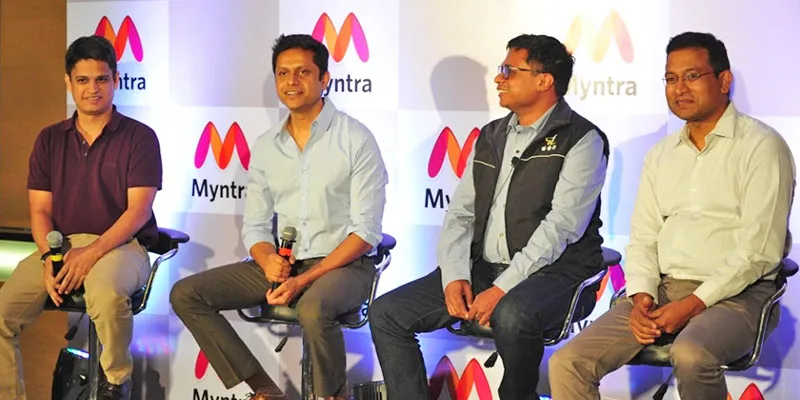From mobile-first to app-only, what makes Myntra confident of the future of m-commerce?
Harshith Mallya

Friday May 15, 2015 , 8 min Read
When Myntra launched its Android app last year, little did they know that within a year, they will not only surpass their own targets in terms of growth in this segment, but will also become an ‘app-only’ platform. Shamik Sharma, Chief Product and Technology officer at Myntra, had said a year ago,
Several studies conducted by us project that smartphones will be the preferred mode of shopping online in the next 12 – 18 months. Already, close to 30% of our business is driven by m-commerce and with the launch of our mobile app, we expect this number to grow to 50% by end of this fiscal (March 2015).
And today, Myntra’s claim that close to 95% of their internet traffic and over 70% of sales comes through mobile devices, testifies their announcement of shutting down the website on May 15th. Myntra announced that the company is transition to an app-only platform, marking the end of desktop and browser based shopping.

“India is a mobile-first internet country for a large portion of the population. And with the way things are going may become a mobile-only internet country in the future,” said Sachin Bansal, Co-founder and CEO of Flipkart, as he explained the thought process behind Myntra’s strategic move. Myntra estimates that the rapid expansion of smartphones from 120-140 million in 2014 to 600-700 million in 2020 will provide the base for creation of an inclusive market for fashion shopping. For a large percentage of the current Indian population, their first taste of high speed internet services would have been through their mobile devices.
Amidst the big numbers were some reactions on the announcement, both positive and negative. Gaurav Dahake, Founder of buyhatke, a price comparison website, says,
Restricting user access and choice for anything is bad. Over 70% of Facebook’s revenue came from mobile ads, but they aren’t shutting their website, even Google which acquired Android, are not going to shut down their website. Companies need to have both mobile and web presence to make product and content discovery easier for consumers.
Smartphones and apps are here to stay
Mobile apps are playing a utilitarian role in a user’s life by being the default mode of accessing and consuming internet services. According to a recent study, 90% of smartphone users in India use apps, which is close to 158 million as of today. The country ranks second only to the US in the usage of shopping apps.
Speaking on this, Sachin Bansal said,
There has been a tremendous growth of smartphones in India and it will continue to multiply over the next few years. Consumers' are shifting fast to smartphones for commerce and information consumption in a big way. Smartphones with apps are becoming utilities that consumers access constantly for their various needs on a daily basis. We are already seeing the development of mobile-based commerce, which will be the most powerful, personalized, intuitive and inclusive market.
While this might seem a logical step for Myntra, for other e-commerce companies things stand at a different junction. The second most valued e-commerce company of India, Snapdeal, has a different opinion. The spokesperson of the company says,
At Snapdeal, the customer is at the centre of all our initiatives. Our data shows that there are still many customers who use PCs to shop online. We do not want to force our customers to use one specific medium to shop on Snapdeal. We will continue to offer our services on both PC and mobile. We do not see this changing in the near future.
Srinidhi Rao, VP- Delivery, Consumer Mobility at Robosoft, believes that the app-only approach makes sense for domains dependent on the transactions (purchases, money transfer, pay bills, and recharges etc). However, domains that are predominantly on the content consumption and advertising revenue based will still continue to have mobile websites along with the apps. He recommends that mobile websites (mostly responsive websites) will provide better coverage and page views when combined with apps.
A more personalized experience
According to Mukesh Bansal, CEO of Myntra and Head of Commerce of Flipkart, smartphones are more powerful than what supercomputers were a few decades ago. He believes that with multiple sensors, GPS, and camera etc, mobile apps will be able to capture multiple data points, which will eventually help Myntra provide a more personal and engaging experience.
The company has found that there has been a positive response to the fashion-focused content and services such as style solutions by stylists, look-good tips and curated offerings backed by a wide selection of brands. The company plans to take the next step by bringing a new experience to its users through features that would enable discovery and consumption of fashion products, content and services -- personalized to individual’s need, taste and choice.

Srinidhi felt that though e-commerce brands may have started out with mobile websites, apps are the way to go as they are a better mode for users. With regular updates and release, the experience will further improve. He says,
The overall user experience, ease of use (with features like single click check out, storing the credit card details etc) and personalization have been the driving force behind this. Additionally, the quality of smartphones and 3G penetrations has certainly enabled these brands to provide better product details to encourage users to make purchase decisions on mobile. Of course, the current analytics on the app usage and revenue generation is extremely positive.
‘Going mobile-only doesn’t mean capturing less market’
Rahul Varshneya, Founder of Arkenea, opines that as brands and online retailers are increasingly seeing more traction from the handheld devices than desktops, it naturally compels them to build an experience for their customers, which is native to that platform. He says,
While going the route of a mobile-only product may seem like a bold step, it doesn’t mean capturing less market. The audiences are already using Uber or Ola apps to book a taxi, using Google Map app to look for directions and are engaging for a considerable time daily on social networks such as Facebook and Twitter. Shutting down website and going mobile-only makes for good press, but at the same time brings down operational costs by maintaining and building for one platform versus multiple. It’s time more brands adapt to the changing user behaviour sooner rather than later, of course, based on the evolution of their own customer segment.
Rajiv Srivatsa, Co-founder of Urban Ladder, shared his thoughts specific to his venture in furniture segment. He says,
“For Urban Ladder, majority of our buyers belong to a different age group as compared to that of a fashion e-commerce company. The decision makers for buying furniture are the people who might not be avid user of smartphones at the moment. Eventually, everyone will come on smartphones in two-three years down the line. It’ll then make more sense for us to go mobile app only. But given the kind of data mobile app collects which in turn enhances the user experience; it makes sense for some to take the plunge.”
Future plans
Myntra claims that more than nine million users have downloaded the app so far. With the introduction of new features, Myntra is targeting the next five million app downloads in three to four months. Over the next six months, Myntra intends to go deeper to make experience more personal.
On being asked whether Flipkart plans to go app-only in the future, Sachin accepted that he had thought of it, but there’s still time for it as the number of categories and services offered on Flipkart are diverse compared to Mnytra’s niche focus: fashion.
Myntra and Flipkart together command a market share of over 50% in the online fashion space and the former has been growing at a fast pace. Myntra intendeds to hit the $1 billion mark in revenues by 2016.The platform receives over 90 million visits every month and services over 12,000 pin codes across the country.
It will be interesting to see how both consumers and other e-commerce giants react to this move. Regarding their competition, Sachin added:
You can’t be competition driven. This is more about how deeply we understand our users and the numbers show that mobile app only is the way to go.
Related reads: Are mobile apps the future? Highlights from Myntra’s mobile hack day
Myntra acquires Bengaluru-based Native5, to boost its mobile app growth
How Myntra plans to create a force of fashion entrepreneurs in India






